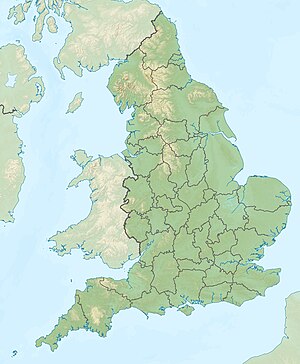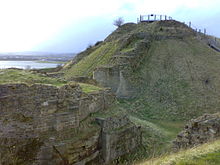Sandal Castle
| Sandal Castle | ||
|---|---|---|
|
Sandal Castle |
||
| Creation time : | around 1100 to 1240 | |
| Conservation status: | ruin | |
| Place: | Wakefield | |
| Geographical location | 53 ° 39 '32 " N , 1 ° 29' 28" W | |
|
|
||
Sandal Castle is a ruined fortress near the town of Wakefield in West Yorkshire , England . Sandal Castle gained historical and literary importance through the Battle of Wakefield , the siege of the fortress by Oliver Cromwell and various scenes from William Shakespeare's Henry VI playing there.
history
Sandal Castle was probably built as early as the 12th century, although it was first mentioned in 1240. The builder is William de Warenne, 2nd Earl of Surrey , who already owned several fortresses. Sandal Castle remained in the possession of the Warenne family until its extinction with the death of John de Warenne, 7th Earl of Surrey in 1347. The fortress and the other family possessions in Yorkshire passed to the Crown.
Edward III. enfeoffed his fourth surviving son Edmund of Langley at the age of six with these goods in the same year . Even after Edmund was raised to Duke of York by his nephew Richard II in 1385 , his family rarely used Sandal Castle.
In 1460, Edmund's grandson Richard Plantagenet, 3rd Duke of York , claimed the throne in the Wars of the Roses and met with Henry VI. the agreement that he would inherit the title after the king's death. Since the wife of Henry VI, Margaret of Anjou , did not accept the disinheritance of her son Edward of Westminster , this led to a new campaign in the autumn and winter of 1460, during which the Battle of Wakefield on December 30, 1460 was almost at the gates came to the fortress. The York troops had left the safe Sandal Castle and were crushed by the superior forces of Lancaster . Richard and his second eldest son, Edmund, Earl of Rutland did not survive the battle.
Richard III , York's youngest son, expanded Sandal Castle, but work came to a standstill after his death in 1485 at the Battle of Bosworth Field . In the following period, rather moderate renovation work was carried out.
During the English Civil War , Sandal Castle was an important fortress for the royal army. In 1645 there were at least three sieges by parliamentary troops and on October 1, 1645 the surrender took place. In 1646 the parliament passed a resolution to demolish the fortress, which had already been badly damaged by military operations.
investment
Sandal Castle is now a popular destination for walkers because of its scenic location. However, this fact leads to constant conflicts between monument conservationists and hikers. To keep the ongoing damage to the ruins as low as possible, a wooden walkway was laid over the ruins in 2003 to prevent ongoing erosion.
literature
- Lawrence Butler: Sandal Castle. The History and Archeology of a Medieval Castle . Wakefield Historical Society, Wakefield, West Yorkshire 1991, ISBN 0-901869-31-7 .


